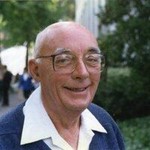
Lucien Le Cam
Professor of Mathematics and Statistics
Lucien Le Cam, one of the most important mathematical statisticians of the 20th century, died on April 25, 2000. His wife of 48 years, Louise Romig Le Cam, their children Denis, Steven, Linda and son-in-law Rick Kreisler, and his brother Jean Le Cam survive him.
Born on November 18, 1924 in Croze, Creuse, France, Le Cam was a “fils de paysans” (roughly, “son of farmers”) in Felletin. He graduated in 1942 from a Catholic boarding school in Guéret. He attended a seminary after high school. Unable to accept that permission was needed from the head priest to read chemistry books, he quit the seminary after one day. By then it was too late in the year to apply for a scholarship in the nearby University of Clermont-Ferrand. His only option, with partial financial support, was to take mathematics courses at a Lycée in Clermont-Ferrand. He gave up chemistry for mathematics, stayed at the Lycée for two years, and then passed the examination in general mathematics set by the University of Clermont-Ferrand. In 1944, he registered as a student at the University of Paris. A job opportunity that required a “certified” statistician prompted him to pass examinations on calculus, rational mechanics, and statistics, whereupon the university awarded him the degree Licence és Sciences in 1945.
Through the introduction of G. Darmois, Director of the Statistical Laboratory of the University of Paris, Le Cam worked for E. Halphen at Electricité de France for the next five years. He investigated how to operate dams for best results and how to estimate probabilities of drought or flood. In his first publication at age 23, he introduced characteristic functionals (after, but independently of, Kolmogorov) to study the temporal and spatial flows of streams. The paper was communicated by Emile Borel to the French Academy. A subsequent publication on precipitation in the Second Berkeley Symposium (1961) is known in hydrology as Le Cam's model.
Le Cam and several other young people formed a weekly seminar on statistics mentored by Darmois at the University of Paris. An encounter with Jerzy Neyman around Easter 1950 resulted in a one-year invitation to Berkeley as an instructor. Urged by Neyman, he stayed as a graduate student and received a Ph.D. in 1952.
Appointed as Assistant Professor of Mathematics in 1953, Le Cam joined the new Department of Statistics at its founding in 1955 and was promoted to full Professor in 1960. He served as department chairman from 1961 to 1965 and was a co-editor with Neyman of the celebrated Berkeley Symposia volumes. Save for a brief stint as Director of the Centre de Recherches Mathematiques, he spent his long and distinguished career in Berkeley.
Le Cam was a principal architect of the modern asymptotic theory of statistics. His life-work was a coherent theory of statistics in which asymptotic “approximations” played a strong role.
His most widely-recognized contributions were the local asymptotic normality condition (LAN) in 1960, the contiguity concept and its consequences, and simple one-step constructions of asymptotically optimal estimates. Around 1970, Jaroslav Hájek and Nobuo Inagaki independently formulated the convolution theorem for parametric estimation. Using Le Cam's LAN concept, Hájek proved the convolution theorem and, in another paper, the local asymptotic minimax theorem under elegantly minimal assumptions. These theorems, as well as Hájek's earlier use of contiguity in studying rank tests, revealed to others the remarkable potential in Le Cam's ideas and popularized them.
While still working on LAN conditions, Le Cam simultaneously tackled a more basic issue in statistical decision theory. He introduced a distance and deficiency between statistical experiments in 1959 and treated insufficiency in 1974. The Le Cam distance and deficiency are fundamentally important in making approximations and asymptotics fit within Wald's (1950) theory of decision functions.
Recent results on the asymptotic equivalence of nonparametric density estimation and nonparametric regression have again revealed the scope of Le Cam's mathematical structure. Since his early work in France, Le Cam viewed himself as a collaborator in scientific investigations in addition to being a theoretical statistician. He worked on stochastic models for rainfall, for sodium channels and more. He co-edited a 1982 book with Neyman, Probability Models and Cancer.
Le Cam's monumental work on asymptotics culminated in his “big” book, Asymptotic Methods in Statistical Decision Theory which was published in 1986. The abstract style of this book and much of his other his work lengthened the time it took for his ideas to have their impact. However, a book published in 1990, Asymptotics in Statistics: Some Basic Concepts, co-authored with Grace Yang, is an elementary version of his magnum opus that facilitated the transmission of his ideas. The manuscript of the second edition was completed just before his death.
He supervised 38 Ph.D. students during his long career, including some who themselves made fundamental contributions: for example, Odd Aalen, who introduced point process ideas to survival analysis. Le Cam's erudition and generosity of ideas were legendary among students and colleagues.
Le Cam's scientific achievements and stature were recognized by the profession and the scientific community. He was Wald Lecturer of the Institute of Mathematical Statistics and Fellow of both U.S. statistical societies and of the American Association for the Advancement of Science. In 1976 he was elected to the American Academy of Arts and Sciences.
On campus and outside, he tended to take strong and not necessarily popular positions as he felt befitted one who not only remained a French citizen throughout his residence in this country, but, in fact, always viewed himself first and foremost as a Breton. Right up to his death, he worked in his office daily from 9-4, his door always open to visitors of any station.
We wish to acknowledge with gratitude the very considerable assistance of Professor Grace Yang of the University of Maryland in preparing this resolution.
David Aldous
Rudolph Beran
Peter Bicke
